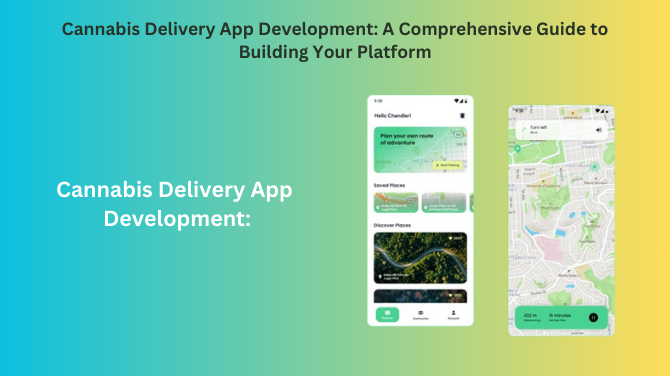Legalizing Marijuana in various parts of the globe has created new markets, especially in digital services. Delivery services, particularly Marijuana, are one of the most profitable segments of this growth market. This is mainly because delivery services are now being offered directly to customers’ doorsteps through delivery applications. This blog will discuss the most crucial aspects, steps, features, and considerations of a cannabis delivery app development.
1. Understanding the Cannabis Delivery Market
The Cannabis Industry is developing, and consumers are seeking out more on-hand strategies for buying the products that they want. That indicates that delivery services are required more when the demand is increased. Delivery apps provide a perfect link between the dispensaries and the customers as they act as shops where the orders are made. First, it is essential to learn and understand the market and its possibilities for creating a popular cannabis delivery application.
Market Trends
- Legalization: There is nothing to suggest that the growth is slowing down, and with more regions legalizing cannabis, the market only tends to grow.
- E-commerce Growth: The change in consumer behaviour toward purchasing goods through the Internet may also affect delivery apps in the cannabis industry.
- Consumer Demand: It is essential to understand that customers look for convenience, personal space, and various products, all of which can be achieved by creating an application.
2. Key Features of a Cannabis Delivery App
In other words, to design an efficient cannabis delivery app, you should include features that suit clients and stores. Below are the essential features that should be included in your App:
For Customers
- User Registration and Verification: Adopt a proper code of conduct for client registration and follow the general legal requirements of age verification.
- Product Listings: Create a list of the various cannabis products available, including details concerning their appearance, description, and the amount of money required to purchase.
- Search and Filter Options: Provide customers with options for finding products that belong to a particular category or strain, affect the user or area, and are in a specific price range.
- Order Tracking: Deliver precise tracking of orders from the dispensary station to the customers’ locations.
- Payment Gateway Integration: This site accepts various forms of payment, such as credit/debit cards, mobile, and bitcoins.
- Ratings and Reviews: Let customers give their opinions on the products and services they are experiencing to gain trust and credibility.
For Dispensaries
- Inventory Management: Record/capture and monitor inventories, change the products’ stock status, and move orders around.
- Order Management: Convenient to check, control, and delivery customers orders.
- Analytics and Reporting: Obtain a summary of the number of sales, customers, and trending products.
- Customer Support: Using live chat or customer support utilities, you can manage queries or complaints.
For Delivery Personnel
- Driver Registration: Enable the driver to enroll where they should complete the necessary paperwork and track deliveries.
- Route Optimization: Serve up better routes for quicker and more efficient deliveries.
- Order Status Updates: Allow the driver to update the order status and relay such information to the customers.
3. Technology Stack for Cannabis Delivery App Development
Selecting the proper technology stack is one of the most significant factors that define the App’s development and success in the cannabis delivery market.
- Frontend Development: For this, one has to build the App under frameworks like React Native, Flutter, or on the Swift platform for iOS and Kotlin for Android devices.
- Backend Development: Know that expensive backend technologies like Node are secure. Other web frameworks such as Java server faces, Django, or Ruby on Rails for handling most of the App’s operations.
- Database Management: Store and manage data with MongoDB, PostgreSQL, or Firebase products.
- Payment Gateway Integration: This involves including third-party charge offerings such as Stripe, PayPal, or other specialized options to fit the requirements of an organization working inside the cannabis marketplace.
- Push Notifications: You can add a cloud-primarily based real-time replacement provider like Firebase Cloud Messaging (FCM) for Android or Apple Push Notification Service (APNS) for iOS.
- Cloud Hosting: Use cloud services such as AWS, Google Cloudure, etc., to ensure the development is scalable and secure.
4. Legal and Compliance Considerations
To be able to function legally, it is imperative for cannabis shipping offerings to strictly adhere to the legal guidelines of the locality, kingdom as well as federal legal guidelines.
- Age Verification: Use stringent procedures to ensure that only those of the eligible age stated in the preliminaries can use the App.
- Licensing: Ensure that your application works in areas where cannabis delivery is legal and acquire all the required licenses.
- Data Privacy: Customers’ facts must be protected using the following information safety pointers, which include GDPR or CCPA.
- Secure Payments: Using a payment gateway that adheres to PCI requirements will enhance the safety of transactions.
5. Monetization Strategies for Cannabis Delivery Apps
Making innovations profitable to ensure the continuation of the cannabis delivery app is very crucial.
- Delivery Fees: Set up a charge every time a delivery is made with the App’s help.
- Subscription Model: You can offer free delivery, discounts, or separate products available only to premium members.
- Advertising: Promote the App and fight for attention from the targeted audience by selling advertisement spots to cannabis brands or companies that produce accessories.
- Commission on Sales: Charge a commission on each sale through the t platform.
6. Steps to Develop a Cannabis Delivery App
One must go through several processes to make the desired cannabis delivery app: add to the group. Here’s a step-by-step guide:
1. Market Research and Planning
- Understand the business opportunities in the market to understand the demographics of your target customers.
- Define the functionality and features that should be implemented in the App.
- Investigate a competitor’s presence in the public market and seek ways to set your App apart.
2. Design and Prototyping
- Sketch out your App’s layouts and develop your application’s screen designs.
- The UX concept should be given attention to have a neatly designed interface with minimal complications.
- Create a preliminary design to assess the application’s performance before starting development.
3. Development
- Organize the backend work and administer the database.
- Sustain the front end with the selected technological platform.
- Some features must be implemented, such as users and their registration, products and displays, and payment options.
4. Testing
- Regarding final testing, strive to crash as often as possible to isolate and eliminate problems.
- Conduct more testing within usability parameters to ensure it receives user accolades.
- Ensure App compatibility by testing it on multiple devices and Operating Systems.
5. Launch and Marketing
- Launch the App on Google Play and App Store (Other relevant App Stores).
- Any App needs target promotion so that it can be downloaded and used more by the clients;
- More visibility can be obtained from social media, SEO, and collaborating with influencers.
6. Post-Launch Support
- They constantly support and update with new changes to meet the users’ feedback.
- Provide customer care services to meet consumers’ concerns or complaints.
- They will have to use just essential tools, which will help monitor this App as it is established and adjusted as required to be successful.
7. Cost Estimation for Cannabis Delivery App Development
The price tag that one is likely to pay on the development of a cannabis delivery app depends on several factors, including;
- Basic App: $20,000 – $40,000 – containing core functionalities like user and product administration and payment processing.
- Advanced App: $100,000 and above – Additional features such as 24/7 tracking, data analysis, and deeper, complex, and enhanced graphical user interface.
- Custom App: More than $100,000 – Different and unique features, extensive combinations with backend systems and processes, and high levels of security.
8. Challenges and Solutions in Cannabis Delivery App Development
That is why growing a hashish delivery app isn’t always as easy as it seems, and it has its peculiarities. Here are some common ones and how to overcome them:
- Regulatory Compliance: It’s essential to remain informed on the marijuana laws in various areas and ensure your software meets them.
- Payment Processing: Select the payment gateways that work with cannabis transactions. Many regular processors do not accept such businesses.
- Security: Proper measures to prevent hacks of the user’s details should enhance the security of their information.
- User Acquisition: Create a compelling marketing approach to acquire and maintain users, especially when there is competition.
Conclusion
Cannabis delivery app development is one of the best chances any businessman will likely get if he wishes to venture into the cannabis business. Specs, compliance, and a sound technology set will allow you to build a successful app that will be highly useful for customers and dispensaries. Fortunately, with the right strategies put in place – those that consider the specifics of the industry and its continual evolution – your cannabis delivery app will be able to grow in this segment successfully.
To expand your business in the cannabis industry, opting to develop an App that delivers cannabis products sets your company apart in the market and delivers products to customers conveniently and unexpectedly. Besides, it includes constant adherence to existing trends and legislation to ensure that the company remains competitive in the long run.
















